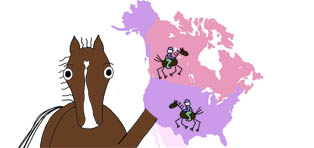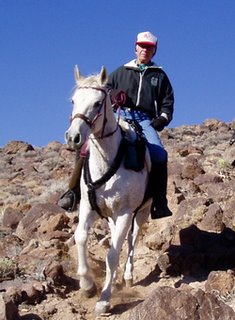
CARL MANNING
Associated Press
LAWRENCE, Kan. - Rob Phillips still remembers his first horse, a paint named Mickey he got more than 50 years ago. It was the start of a lifelong love affair with horses that's led to plans for an endurance race over the Santa Fe Trail.
For the past year, the 62-year-old retired real estate developer and his wife, Beverly, have been putting together The Great Santa Fe Trail Horse Race. It starts Sept. 3 in Santa Fe, N.M. and ends Sept. 15 in Missouri, broken down into 10 rides of about 50 miles a day over 515 miles.
Phillips got the idea after hearing the story of Francis X. Aubry, a trader who in 1848 made a $1,000 bet that he could traverse the trail from Santa Fe to its start in Independence, Mo., in six days. He took five days and 16 hours to cover the 800-mile route that normally took a month and established a record that stands to this day.
"When I heard that story, I thought we've got to do something about the Santa Fe Trail and get the world excited about it again," Phillips said.
Besides that, Phillips wanted to do something productive.
"You've got to have something to do. You can dry the dishes only so many times," he said.
So he came up with the endurance ride which will follow the wide, meandering trail that cuts southwest through 16 Kansas counties. The riders will cover the sweeping landscape of open prairies and rolling plains that greeted travelers heading west with trade goods or in search of a better place to live.
"It will always be near to what we consider the trail. We're in real close proximity and I doubt we'll spend a night on land that wasn't camped on by people in covered wagons," Phillips said.
The trail opened in 1821 when Missouri trader William Becknell became the first to use it to haul goods by mule train to Santa Fe, then part of Mexico.
Although some settlers used the trail, it primarily was a trade route for bringing manufactured goods to Santa Fe and taking silver and other valuables back to Missouri. By 1880, the trail was eclipsed by the railroads and only the wagon ruts remained.
"It set up a new excitement about trading and the expansion in the west," said Rita Napier, University of Kansas history professor. "It represents a reaching out to expand."
Napier said the trail was important because more trade meant more manufacturing but it was especially important to Kansas because it helped shape the state's growth.
"Once the territory was opened, it was a route that towns grabbed onto because there was a certainty of money coming in through trade," Napier said. "The Santa Fe Railroad followed the trail, which resulted in more towns."
With that historic backdrop, Phillips put together what he hopes will be an annual event.
"If you are going to do something, you might as well do it big, and if it's big you can see it," he said.
He expects to have 100 teams with about 500 horses dashing over the landscape. Already, people from 17 states have signed up, paying entry fees ranging from $3,500 to $4,500.
At first there was talk of prize money, but Phillips discarded the idea because he wanted the race to be more about the love of the sport than getting money.
But, he added, winning has its own rewards.
"It's about pride. It's a once-in-a-lifetime accomplishment," Phillips said. "Can you imagine? You can say you rode a race on the Santa Fe trail and won."
After a long day in the saddle, riders will be able to rest at the "race village," a 30-acre area resembling a traveling fair, set up in 11 locations, including Elkart, Dodge City, Larned, Lyons, Council Grove, Burlingame and Gardner.
Each morning, it will move to where the riders will be at the end of that day's race. It will include food vendors, a dining tent, merchants, farriers, veterinarians and places for riders to clean up and rest.
Phillips said the race has attracted several sponsors, including the RFD-TV cable-satellite network, the U.S. Postal Service, the Bureau of Land Management and the Kansas Lottery.
The Imus Ranch, a New Mexico ranch owned by radio personality Don Imus that helps children with cancer, is the event's designated charity and will get a portion of the entry and sponsor fees.
There also will be a re-enactment of a Pony Express ride, with riders carrying mail from Santa Fe to Independence with 30 stops along the way.
With the original Pony Express, young men rode 75 to 100 miles before handing off the mochila, or mail pouch, to the next rider. This time, it will be six riders alternating in relays over the 800 miles that won't be on the trail but close to it.
"Now we have cell phones and pickup trucks," Phillips said. "Our riders won't be going that far."
ON THE NET
Santa Fe Trail Race: http://www.sfthorserace.com/









